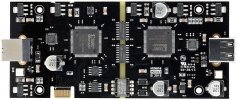solderdude
Grand Contributor
Yes, you still can get a groundloop because the data needs a ground which will always be connected.
In theory, when a groundloop is present you could disconnect the ground so would only have the 2 data wires connected. There are some gizmo's doing that like the ifi I believe. Not all DAC's like that though.
The +5V wire is not the issue in most cases, the ground connection is.
In theory, when a groundloop is present you could disconnect the ground so would only have the 2 data wires connected. There are some gizmo's doing that like the ifi I believe. Not all DAC's like that though.
The +5V wire is not the issue in most cases, the ground connection is.
Last edited:


